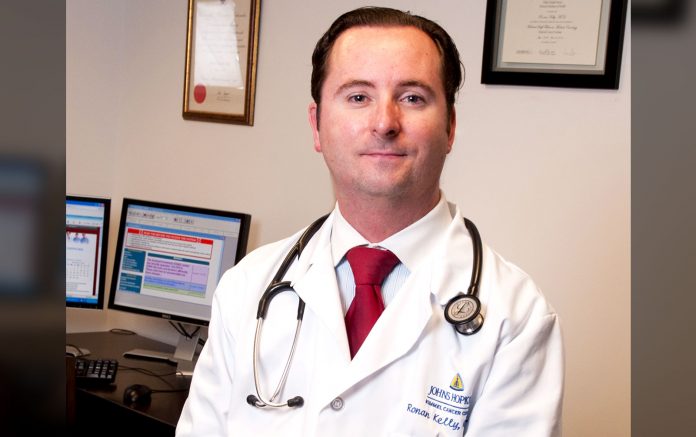Posted: February 2017
Q&A with with Ronan J. Kelly, MB BCh, MBA
Q: What is the impetus for the development of clinical pathways?
A: The incidence of cancer in the US is expected to increase by 45% in the next 2 decades, from 1.6 million in 2010 to 2.3 million in 2030. Direct medical costs associated with cancer care are also expected to increase from $125 billion in 2010 to at least $173 billion in 2020, and this may be a conservative estimate. This price escalation is not sustainable, and there are a number of systemic failures, which drive up costs, in our cancer care delivery system that need to be rectified. The Institute of Medicine estimates that approximately 30% of all healthcare dollars are spent on unnecessary tests, procedures, and doctor visits. Clinical pathways are a set of systems-based tools or protocols for creating greater cohesion in cancer care by standardizing decisionmaking, therapeutic selection, and care delivery. Essentially, they are seen as a method to reduce unnecessary and costly treatment variations. Pathway developers say their pathways are chosen based on efficacy, toxicity, and cost, in that order.
Q: What evidence exists to show that such pathways reduce costs, reduce medical errors, and improve outcomes, including survival?
A: One of the best-known studies in nonsmall cell lung cancer comes from The US Oncology Network, which reported no differences in overall survival in patients treated in the adjuvant setting or in the first-line and second-line metastatic setting when treated on or off their level 1 pathway, but costs were reduced by 35% when treated on pathway vs off pathway. We do, however, need more evidence to show that pathways not only reduce costs and medical errors but also improve survival. Studies to date have been small and have used observational designs or retrospectively identified control groups. Future studies performed by large independent groups to assess the long-term clinical and economic outcomes in realworld setting are needed. We also need to pursue a collaborative, national approach in the US to reduce the unsustainable administrative burden associated with clinical pathways and to ensure they are consistent and transparent.
Q: What are the impediments to the implementation of such pathways?
A: It was anticipated that the biggest challenges to pathway adoption would not be technical or operational, but rather cultural, and that oncologists would reject standardization and measurement over their own autonomy and clinical judgment. Some success has been achieved by fostering a collaborative approach where physicians are directly involved in pathway development, and aligned incentives are agreed upon up front. As we move forward, pathway development success is more about changing entrenched physician behavior patterns rather than merely revising formularies. While large oncology groups like UPMC and The US Oncology Network have been able to win consensus among their oncologists, achieving this throughout an entire insurer’s network will be more difficult. Concerns still exist; a recent ASCO task force highlighted that, in many cases, clinical pathways are undermining physicians’ ability to optimally care for their patients with cancer and they are limiting patient choice.
The ASCO task force raised a number of concerns regarding how clinical pathways are developed and implemented in practices. Key points from the policy statement include the following: (a) Oncology pathways are not developed or applied consistently by insurers, thereby resulting in wide variations in quality and utility; (b) Pathways are often too rigid and often overemphasize cost control; (c) Pathways overemphasize drugs, but do not include other critical aspects of care such as diagnostics, laboratory investigations, or palliative care services; (d) Lack of transparency in the pathway development process may lead to conflicts of interest; and (e) No system is in place to guarantee the integrity of the various pathways coming to market or to ensure they are implemented in a manner that supports high-quality patient care.
Q: Will the status of the Affordable Care Act influence the institution of such pathways? Or do you believe these algorithms are inevitable regardless of the existence of the Act?
A: I believe these algorithms are inevitable; the current marketplace and the Affordable Care Act have led to an increase in high-deductible health plans, which have exacerbated the significant financial hardships experienced by patients with expensive chronic conditions such as cancer. Clinical pathways are seen as a way to decrease costs, which hopefully will make care more affordable for patients. A recent ASCO policy statement on clinical pathways estimates that 60 individual health insurance plans in the US are currently implementing oncology pathways; this means that approximately 170 million individuals covered by those plans will potentially be treated under an oncology pathway if they develop cancer.
Q: In the 80s, the cost of one year of hemodialysis was approximately $50,000. What, if any, is the current threshold for cost per life year gained? Should there be such thresholds? What ethical issues does this analysis raise?
A: All countries are struggling with the appropriate amount to spend on healthcare. Each country has its own regulatory body to evaluate new cancer drugs, and each country uses different thresholds to determine what is considered good value or cost-effective prior to approving a new treatment. In the US there is no explicit “line in the sand” used for a maximally acceptable incremental cost-effectiveness ratio (ICER), which is a statistic used to summarize the cost-effectiveness of a health care intervention. Three different approaches—adjusting the ICER for dialysis into current dollars, using three times a country’s gross domestic product, and an inflation-adjusted index—suggest an acceptable threshold range of $150,000 to $200,000 per quality-adjusted life-year gain (QALY). For a number of years, I and others have proposed that cost-effectiveness analyses must be used to form policy around national healthcare plans, recognizing that each country will have different thresholds.











